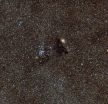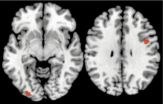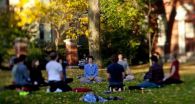(Press-News.org) This part of the constellation of Sagittarius (The Archer) is one of the richest star fields in the whole sky -- the Large Sagittarius Star Cloud. The huge number of stars that light up this region dramatically emphasise the blackness of dark clouds like Barnard 86, which appears at the centre of this new picture from the Wide Field Imager, an instrument mounted on the MPG/ESO 2.2-metre telescope at ESO's La Silla Observatory in Chile.
This object, a small, isolated dark nebula known as a Bok globule [1], was described as "a drop of ink on the luminous sky" by its discoverer Edward Emerson Barnard [2], an American astronomer who discovered and photographed numerous comets, dark nebulae, one of Jupiter's moons, and made many other contributions. An exceptional visual observer and keen astrophotographer, Barnard was the first to use long-exposure photography to explore dark nebulae.
Through a small telescope Barnard 86 looks like a dearth of stars, or a window onto a patch of distant, clearer sky. However, this object is actually in the foreground of the star field -- a cold, dark, dense cloud made up of small dust grains that block starlight and make the region appear opaque. It is thought to have formed from the remnants of a molecular cloud that collapsed to form the nearby star cluster NGC 6520, seen just to the left of Barnard 86 in this image.
NGC 6520 is an open star cluster that contains many hot stars that glow bright blue-white, a telltale sign of their youth. Open clusters usually contain a few thousand stars that all formed at the same time, giving them all the same age. Such clusters usually only live comparatively short lives, on the order of several hundred million years, before drifting apart.
The incredible number of stars in this area of the sky muddles observations of this cluster, making it difficult to learn much about it. NGC 6520's age is thought to be around 150 million years, and both this star cluster and its dusty neighbour are thought to lie at a distance of around 6000 light-years from our Sun.
The stars that appear to be within Barnard 86 in the image above are in fact in front of it, lying between us and the dark cloud. Although it is not certain whether this is still happening within Barnard 86, many dark nebulae are known to have new stars forming in their centres -- as seen in the famous Horsehead Nebula (eso0202 - http://www.eso.org/public/news/eso0202/), the striking object Lupus 3 (eso1303) and to a lesser extent in another of Barnard's discoveries, the Pipe Nebula (eso1233 - http://www.eso.org/public/news/eso1233/). However, the light from the youngest stars is blocked by the surrounding dusty regions, and they can only be seen in infrared or longer-wavelength light.
INFORMATION:
Notes
[1] Bok globules were first observed in the 1940s by astronomer Bart Bok. They are very cold, dark clouds of gas and dust that often have new stars forming at their centres. These globules are rich in dust that scatters and absorbs background light, so they are almost opaque to visible light.
[2] This quotation comes from E. E. Barnard, Dark Regions in the Sky Suggesting an Obscuration of Light, Yerkes Observatory, Nov 15 1913 (available online here: http://adsabs.harvard.edu/full/1913ApJ....38..496B).
More information
ESO, the European Southern Observatory, is the foremost intergovernmental astronomy organisation in Europe and the world's most productive astronomical observatory. It is supported by 15 countries: Austria, Belgium, Brazil, the Czech Republic, Denmark, France, Finland, Germany, Italy, the Netherlands, Portugal, Spain, Sweden, Switzerland and the United Kingdom. ESO carries out an ambitious programme focused on the design, construction and operation of powerful ground-based observing facilities enabling astronomers to make important scientific discoveries. ESO also plays a leading role in promoting and organising cooperation in astronomical research. ESO operates three unique world-class observing sites in Chile: La Silla, Paranal and Chajnantor. At Paranal, ESO operates the Very Large Telescope, the world's most advanced visible-light astronomical observatory and two survey telescopes. VISTA works in the infrared and is the world's largest survey telescope and the VLT Survey Telescope is the largest telescope designed to exclusively survey the skies in visible light. ESO is the European partner of a revolutionary astronomical telescope ALMA, the largest astronomical project in existence. ESO is currently planning the 39-metre European Extremely Large optical/near-infrared Telescope, the E-ELT, which will become "the world's biggest eye on the sky".
Links
* Information about the MPG/ESO 2.2-metre telescope: http://www.eso.org/sci/facilities/lasilla/telescopes/2p2/
* Information about the La Silla Paranal Observatory: http://www.eso.org/public/teles-instr/lasilla.html
* Images of La Silla: http://www.eso.org/public/images/archive/category/lasilla/
Contacts
Richard Hook
ESO, La Silla, Paranal, E-ELT and Survey Telescopes Public Information Officer
Garching bei München, Germany
Tel: +49 89 3200 6655
Cell: +49 151 1537 3591
Email: rhook@eso.org
'A drop of ink on the luminous sky'
Wide Field Imager snaps cosmic gecko
2013-02-13
ELSE PRESS RELEASES FROM THIS DATE:
Study suggests infant deaths can be prevented
2013-02-13
(TORONTO, Canada – Feb. 13, 2013) – An international team of tropical medicine researchers have discovered a potential method for preventing low birth weight in babies born to pregnant women who are exposed to malaria. Low birth weight is the leading cause of infant death globally.
The findings of Malaria Impairs Placental Vascular Development, published today online ahead of print in Cell Host & Microbe, showed that the protein C5a and its receptor, C5aR, seem to control the blood vessel development in the mother's placenta. Without adequate blood vessels in the placenta, ...
Carnegie Mellon brain imaging research shows how unconscious processing improves decision-making
2013-02-13
PITTSBURGH—When faced with a difficult decision, it is often suggested to "sleep on it" or take a break from thinking about the decision in order to gain clarity.
But new brain imaging research from Carnegie Mellon University, published in the journal "Social Cognitive and Affective Neuroscience," finds that the brain regions responsible for making decisions continue to be active even when the conscious brain is distracted with a different task. The research provides some of the first evidence showing how the brain unconsciously processes decision information in ways ...
Study in mice yields Angelman advance
2013-02-13
PROVIDENCE, R.I. [Brown University] — In a new study in mice, a scientific collaboration centered at Brown University lays out in unprecedented detail a neurological signaling breakdown in Angelman syndrome, a disorder that affects thousands of children each year, characterized by developmental delay, seizures, and other problems. With the new understanding, the team demonstrated how a synthesized, peptide-like compound called CN2097 works to restore neural functions impaired by the disease.
"I think we are really beginning to understand what's going wrong. That's what's ...
A neural basis for benefits of meditation
2013-02-13
PROVIDENCE, R.I. [Brown University] — Why does training in mindfulness meditation help patients manage chronic pain and depression? In a newly published neurophysiological review, Brown University scientists propose that mindfulness practitioners gain enhanced control over sensory cortical alpha rhythms that help regulate how the brain processes and filters sensations, including pain, and memories such as depressive cognitions.
The proposal, based on published experimental results and a validated computer simulation of neural networks, derives its mechanistic framework ...
Wetland trees a significant overlooked source of methane, study finds
2013-02-13
Wetlands are a well-established and prolific source of atmospheric methane. Yet despite an abundance of seething swamps and flooded forests in the tropics, ground-based measurements of methane have fallen well short of the quantities detected in tropical air by satellites.
In 2011, Sunitha Pangala, a PhD student at The Open University, who is co-supervised by University of Bristol researcher Dr Ed Hornibrook, spent several weeks in a forested peat swamp in Borneo with colleague Sam Moore, assessing whether soil methane might be escaping to the atmosphere by an alternative ...
3 'Bigfoot' genomes sequenced in 5-year DNA study
2013-02-13
Dallas, Feb. 13--The multidisciplinary team of scientists, who on November 24, 2012 announced the results of their five-year long study of DNA samples from a novel hominin species, commonly known as "Bigfoot" or "Sasquatch," publishes their peer-reviewed findings today in the DeNovo Journal of Science (http://www.denovojournal.com). The study, which sequenced three whole Sasquatch nuclear genomes, shows that the legendary Sasquatch is extant in North America and is a human relative that arose approximately 13,000 years ago and is hypothesized to be a hybrid cross of modern ...
European satellite confirms UW numbers: Arctic Ocean is on thin ice
2013-02-13
The September 2012 record low in Arctic sea-ice extent was big news, but a missing piece of the puzzle was lurking below the ocean's surface. What volume of ice floats on Arctic waters? And how does that compare to previous summers? These are difficult but important questions, because how much ice actually remains suggests how vulnerable the ice pack will be to more warming.
New satellite observations confirm a University of Washington analysis that for the past three years has produced widely quoted estimates of Arctic sea-ice volume. Findings based on observations from ...
We're emotionally distant and that's just fine by me
2013-02-13
When it comes to having a lasting and fulfilling relationship, common wisdom says that feeling close to your romantic partner is paramount. But a new study finds that it's not how close you feel that matters most, it's whether you are as close as you want to be, even if that's really not close at all.
"Our study found that people who yearn for a more intimate partnership and people who crave more distance are equally at risk for having a problematic relationship," says the study's lead author, David M. Frost, PhD, of Columbia University's Mailman School of Public Health. ...
Video study shows which fish clean up coral reefs, showing importance of biodiversity
2013-02-13
Using underwater video cameras to record fish feeding on South Pacific coral reefs, scientists have found that herbivorous fish can be picky eaters – a trait that could spell trouble for endangered reef systems.
In a study done at the Fiji Islands, the researchers learned that just four species of herbivorous fish were primarily responsible for removing common and potentially harmful seaweeds on reefs – and that each type of seaweed is eaten by a different fish species. The research demonstrates that particular species, and certain mixes of species, are potentially critical ...
Penn vet team uncovers a pathway that stimulates bone growth
2013-02-13
PHILADELPHIA — Researchers from the University of Pennsylvania School of Veterinary Medicine have discovered that a protein called Jagged-1 stimulates human stem cells to differentiate into bone-producing cells. This protein could help both human and animal patients heal from bone fractures faster and may form the basis of treatments for a rare metabolic condition called Alagille syndrome.
The study, published in the journal Stem Cells, was authored by three members of Penn Vet's departments of Clinical Studies-New Bolton Center and Animal Biology: postdoctoral researchers ...
LAST 30 PRESS RELEASES:
Scientists discover ‘platypus galaxies’ in the early universe
Seeing thyroid cancer in a new light: when AI meets label-free imaging in the operating room
Neutrophil-to-lymphocyte ratio may aid risk stratification in depressive disorder
2026 Seismological Society of America Annual Meeting
AI-powered ECG analysis offers promising path for early detection of chronic obstructive pulmonary disease, says Mount Sinai researchers
GIMM uncovers flaws in lab-grown heart cells and paves the way for improved treatments
Cracking the evolutionary code of sleep
Medications could help the aging brain cope with surgery, memory impairment
Back pain linked to worse sleep years later in men over 65, according to study
CDC urges ‘shared decision-making’ on some childhood vaccines; many unclear about what that means
New research finds that an ‘equal treatment’ approach to economic opportunity advertising can backfire
Researchers create shape-shifting, self-navigating microparticles
Science army mobilizes to map US soil microbiome
Researchers develop new tools to turn grain crops into biosensors
Do supervised consumption sites bring increased crime? Study suggests that’s a myth
New mass spec innovation could transform research
Maternal nativity, race, and ethnicity and infant mortality in the US
Migration-related trauma among asylum seekers exposed to the migrant protection protocols
Jupiter’s moon Europa has a seafloor that may be quiet and lifeless
SwRI upgrades nuclear magnetic resonance laboratory for pharmaceutical R&D
House sparrows in northern Norway can help us save other endangered animals
Crohn's & Colitis Foundation survey reveals more than 1/3 of young adults with IBD face step therapy insurance barriers
Tethered UAV autonomous knotting on environmental structures for transport
Decentralized social media platforms unlock authentic consumer feedback
American Pediatric Society announces Vanderbilt University School of Medicine as host institution for APS Howland Visiting Professor Program
Scientists discover first method to safely back up quantum information
A role for orange pigments in birds and human redheads
Pathways to net-zero greenhouse gas emissions for Southeast Asia
A JBNU–KIMS collaborative study on a cost-effective alloy matches superalloys for power plants and energy infrastructure
New study overturns long-held model of how plants coordinate immune responses.
[Press-News.org] 'A drop of ink on the luminous sky'Wide Field Imager snaps cosmic gecko





